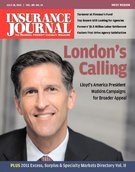The California Supreme Court has confirmed a limitation on an employer’s potential tort liability for the acts of its employees, with a particular emphasis on employees operating motor vehicles in the course of their employment.
According to Diaz v. Carcamo, Dawn Renae Diaz was driving in Ventura County, Calif., when Jose Carcamo, a truck driver for Sugar Transport of the Northwest LLC, was driving north in the center of three lanes. Karen Tagliaferri, driving in the center lane behind Carcamo, moved to the left lane to pass him. As Tagliaferri, without signaling, pulled back into the center lane, her vehicle hit Carcamo’s truck, spun, flew over the divider, and hit Diaz’s SUV, and she sustained severe, permanent injuries. Diaz subsequently filed a lawsuit against Tagliaferri, Carcamo, and Sugar Transport, alleging that Carcamo and Tagliaferri had driven negligently, and that Sugar Transport was both vicariously liable for employee Carcamo’s negligent driving and directly liable for its own negligence in hiring and retaining him.
The jury found that defendants Tagliaferri and Carcamo had driven negligently, that defendant Sugar Transport had been negligent in hiring and retaining Carcamo as a driver, and that the retention was a cause of plaintiff’s injuries. The jury allocated fault for the accident among all three defendants: 45 percent to Tagliaferri, 35 percent to Sugar Transport, and 20 percent to Carcamo. It awarded plaintiff over $17.5 million in economic damages and $5 million in noneconomic damages. A Court of Appeal affirmed that decision.
The Supreme Court reversed the Appeals Court decision, which allowed plaintiffs to pursue “alternative” tort claims against an employer, such as negligent hiring and retention — even after the employer admitted to “respondeat superior” liability.
“If, as here, an employer offers to admit vicarious liability for its employee’s negligent driving, then claims against the employer based on theories of negligent entrustment, hiring, or retention become superfluous. To allow such claims in that situation would subject the employer to a share of fault in addition to the share of fault assigned to the employee, for which the employer has already accepted liability,” the high court wrote. “To assign to the employer a share of fault greater than that assigned to the employee whose negligent driving was a cause of the accident would be an inequitable apportionment of loss.”
While the ruling was decided under California law, it has a national impact, as cases covering this subject are frequently litigated throughout the country and most jurisdictions have followed California’s lead on this subject, according to SNR Denton, which argued the case before the Court of Appeal.
“The Supreme Court’s decision reflects wise public policy analysis as well as a recognition of the fundamental rights of employers who hire drivers in the course of their business,” said Paul E. B. Glad, a partner in SNR Denton’s San Francisco office. “On the one hand, it provides employers with a strong incentive to acknowledge respondeat superior liability, making them strictly liable for injuries caused by their employee. On the other hand, it protects the individual driver and his employer from the introduction of prejudicial character evidence — including evidence of prior accidents — which otherwise might be admissible to prove negligent entrustment, hiring and retention. There is something in this for everyone.”
Topics California Commercial Lines Talent Business Insurance
Was this article valuable?
Here are more articles you may enjoy.


 Project 2025 Plan to End NFIP Welcomed by Some, Rejected by Others in Insurance
Project 2025 Plan to End NFIP Welcomed by Some, Rejected by Others in Insurance  Allstate Reports Second Quarter Pretax Catastrophe Losses of $2.1B
Allstate Reports Second Quarter Pretax Catastrophe Losses of $2.1B  FM Global Rebrands As FM
FM Global Rebrands As FM  P/C Premium Growth Likely But Profits Delayed Until 2025: Forecast
P/C Premium Growth Likely But Profits Delayed Until 2025: Forecast 


